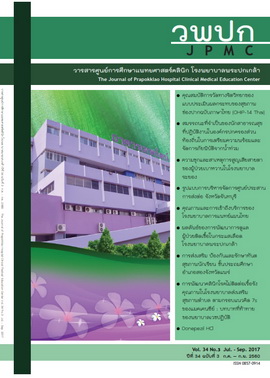คุณสมบัติการวัดทางจิตวิทยาของแบบประเมินผลกระทบของสุขภาพช่องปากฉบับภาษาไทย (OHIP-14Thai)
Main Article Content
Abstract
ที่มาของปัญหา: เครื่องมือวัดคุณภาพชีวิตในมิติสุขภาพช่องปากได้มีการใช้อย่างแพร่หลายมากขึ้นในการประเมินผลกระทบของปัญหาสุขภาพช่องปากต่อคุณภาพชีวิต หนึ่งในเครื่องมือที่ได้รับความนิยมอย่างมากคือแบบประเมินผลกระทบของสุขภาพช่องปาก (Oral health Impact Profile: OHIP-14) ซึ่งเครื่องมือดังกล่าวยังไม่เคยผ่านการทดสอบคุณสมบัติการวัดทางจิตวิทยาเพื่อนำมาใช้งานในประเทศไทยเลย
วัตถุประสงค์: เพื่อประเมินคุณสมบัติการวัดทางจิตวิทยาของแบบประเมินผลกระทบของสุขภาพช่องปากฉบับภาษาไทย (OHIP-14Thai) ในประชาชนชาวไทย
วิธีการศึกษา: การศึกษานี้เป็นการศึกษาแบบตัดขวางในเขตตำบลวัฒนานคร อำเภอวัฒนานคร จังหวัดสระแก้ว โดยใช้แบบประเมิน OHIP-14 ที่ได้รับการแปลให้เป็นภาษาไทยแล้วจากต้นฉบับภาษาอังกฤษ และใช้แบบประเมินภาษาไทยดังกล่าวในการสัมภาษณ์ผู้สูงอายุ (อายุ 60 ปีขึ้นไปจำนวน 180 คน) โดยผู้สัมภาษณ์ที่ผ่านการฝึกฝนแล้ว ร่วมกับการเก็บข้อมูลทั่วไปและข้อมูลสภาวะในช่องปาก เพื่อการทดสอบความตรงและความเชื่อถือได้ในการประเมินคุณสมบัติการวัดทางจิตวิทยาของแบบประเมิน OHIP-14Thai
ผลการศึกษา: การทดสอบความตรงเชิงลู่เข้าของแบบประเมิน OHIP-14Thai พบว่าคะแนนรวมของ OHIP-14Thai มีความสัมพันธ์อย่างมากกับคะแนนการประเมินทันตสุขภาพด้วยตนเอง และคะแนนการประเมินตนเองต่อความจำเป็นในการรักษาทางทันตกรรม ความสัมพันธ์อย่างมีนัยสำคัญระหว่างคะแนน OHIP-14Thai กับการเกิดโรคฟันผุ จำนวนฟันที่หายไป จำนวนฟันแท้ในช่องปาก การใส่ฟันเทียมและสภาวะปริทันต์ แสดงให้เห็นความตรงเชิงจำแนกของ OHIP-14Thai ในการจำแนกอาการต่าง ๆ ดังที่กล่าวมาได้ การทดสอบความเที่ยงโดยสัมประสิทธิ์ความสม่ำเสมอภายในโดยใช้ค่า Cronbach’s alpha ของ OHIP-14Thai พบว่าค่าที่ได้สูงกว่าค่ามาตรฐานที่ต้องการคือ 0.7 ขึ้นไป และค่าสัมประสิทธิ์ความคงที่ ทดสอบโดยใช้ค่า ICC ได้ค่า 0.92 (95% CI: 0.89-0.94)
สรุป: คุณสมบัติการวัดทางจิตวิทยาของแบบประเมินผลกระทบของสุขภาพช่องปากฉบับภาษาไทย (OHIP-14Thai) แสดงให้เห็นว่ามีความตรงเชิงโครงสร้างที่ดีและยอมรับได้ในความเที่ยงของเครื่องมือ สามารถใช้วัดคุณภาพชีวิตในมิติสุขภาพช่องปากในผู้สูงอายุชาวไทยได้
Psychometric properties of Thai version of the oral health impact profile (OHIP-14Thai)
Background: The oral health-related quality of life instruments are increasingly used to evaluate the impact of the oral problems on quality of life. One of most used instrument is Oral Health Impact Profile (OHIP-14), but it has never been tested the psychometric properties for implementation in Thailand.
Objective: To validate the psychometric properties of Thai version of the oral health impact profile (OHIP-14Thai) among Thai populations.
Method: A cross-sectional study was performed in Tambon Watthana Nakhon, Watthana Nakhon District, Sa Kaeo Province. The original English version of OHIP-14 was translated into Thai. Elderly persons ages 60 years and above (n=180) were interviewed by a trained interview. Information on subjects’ demographic background and oral health status were collected. Validity tests and Reliability analyses were carried out to evaluate the psychometric properties of OHIP-14Thai.
Results: Convergent validity of OHIP-14Thai was supported by the finding that total score was highly associated with self-perceived oral health status and perceived need for dental care. Significant associations were found between OHIP-14Thai and the decayed teeth, missing teeth, teeth present, teeth wear and periodontal health, supporting Discriminant validity of OHIP-14Thai to discriminate several of oral health status as above. The internal consistency reliability (Cronbach’s alpha) of OHIP-14Thai was above the recommended 0.7 threshold and the coefficient of stability measured by ICC was 0.92 (95% CI: 0.89-0.94)
Conclusion: Thai version of the oral health impact profile (OHIP-14Thai) demonstrated good construct validity and acceptable reliability. It is available to measure the oral health-related quality of life in Thai elderly populations.
